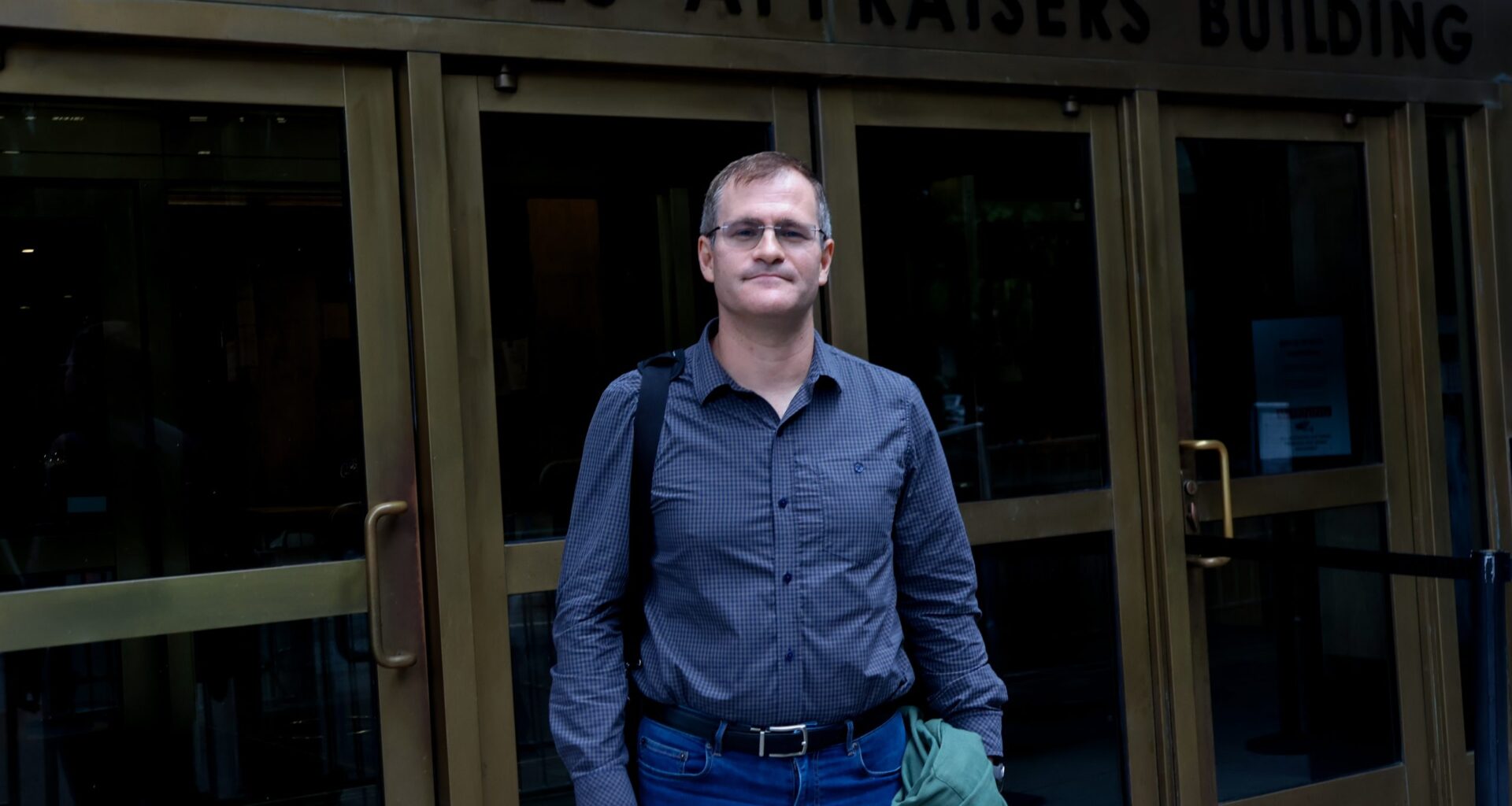
Sign up below to get Mission Local’s free newsletter, a daily digest of news you won’t find elsewhere.
On a recent Thursday morning, Nicholas Weininger waited in a long line of people outside the San Francisco immigration court for a security guard to let him in.
At 8 a.m., the guard promptly opened the door. From there, Weininger took the elevator up to the fourth floor of 630 Sansome St. that houses the Immigration and Customs Enforcement field office and the immigration court, where the schedule of hearings is posted for the building’s two courtrooms.
By 8:30 a.m., he was inside the courtroom of Judge Patrick O’Brien, seated to watch the proceedings unfold with a form in his hand to jot down case details. Beside him, two young Colombian women sat nervously, one of them with tears in her eyes. On his other side, a Mexican mother and daughter talked among themselves.

Want the latest on the Mission and San Francisco? Sign up for our free daily newsletter below.
For the past month and a half, Weininger, who runs his own engineering-management consulting business in S.F., has been coming here once a week and sitting in on asylum hearings. He is one of nearly 200 people trained by the Bar Association of San Francisco to court watchers.
In court, he has to keep up with the fast pace of proceedings, writing down the name of each person called, their nine-digit ‘A-number,’ their address, and whether the Department of Homeland Security attorney has made a motion to dismiss the person’s case.
“The main thing we’re trying to do in this program is look out for dismissals,” said Weininger, TK AGE, on that Thursday morning. “The dismissal somehow provides an excuse for Immigration Customs and Enforcement to arrest these people and later deport them.”
Mission Local has tracked these motions to dismiss since late May and has documented 130 arrests at Sansome Street or San Francisco’s other immigration court at 100 Montgomery St. Many of those attending court at either building are seeking asylum, meaning they fear persecution in their home countries.
That morning in Sansome, O’Brien had about 25 cases on his docket who had all received notices to appear, indicating that each immigrant had been placed into removal proceedings to be deported.
Most days, one or two attorneys working for the Bar Association’s pro-bono Attorney of the Day program are in the Sansome courtroom with Weininger. That day, two attorneys of the day were present to give asylum-seekers legal advices throughout the morning’s hearings.
When DHS moves to dismiss, these attorneys quickly file habeas petitions — challenging the grounds for detention — and have had a 100 percent success rate at releasing immigrants from detention within a short time frame, according to Milli Atkinson, the director of the Bar’s immigrant legal defense program.
But if there are no lawyers present, the asylum-seeker is detained without legal counsel. When that happens, the court watchers are key: The data they collect can be used to track the whereabouts of detainees, provide legal aid, and look for larger patterns, like what kinds of people DHS is motioning to dismiss and detain. It can be used by the Bar Association to determine who needs a habeas petition filed on their behalf later on.
To Weininger, this is all personal. In the 1920s, his Jewish grandfather fled rising antisemitism after the collapse of the Austro-Hungarian Empire and found safe harbor in the United States. His grandfather was able to come to the country, he said, because he arrived before the Immigration Act of 1924 made laws much more restrictive.
Two generations later, as the Trump administration has instituted more restrictions and began expediting deportations, Weininger realized he needed to do something beyond just feeling bad about it.
“When I see people being mistreated, that’s the call to consciousness,” he said. Many of his grandfather’s relatives, Weininger said, were not able to escape the Holocaust and were killed in present-day Ukraine during the Second World War.
He searched online for volunteer opportunities and found the American Bar Association’s Court Watch program, a nationwide network that trains volunteers to observe immigration courts whose proceedings are open to the public. Weininger is now one of the volunteers managed by the San Francisco Bar Association
Weininger, who lives in the Forest Hill neighborhood, balances his time as a Court Watch observer with his days as a husband, father, and his consulting business. “That’s the rhythm of my life,” he said.
When he’s not working, he’s singing with the International Orange Chorale of San Francisco and the San Francisco Choral, or composing music. In a few weeks, Weininger will travel to Seattle to debut his most recent composition: a contemporary music piece written for a friend’s acapella choir, “Nothing Gold.”
But for the meantime he’s still in court. That Thursday morning, DHS attorneys filed motions to dismiss three of the asylum cases. O’Brien granted each motion, which often leads to immediate arrest by ICE once an asylum-seeker leaves the courtroom.
But, ICE was nowhere to be seen. Through it all, Weininger remained calm and attentive, looking up and down from his intake form through a pair of rectangular glasses.
Weininger said he’s “happy” to be part of a community that supports immigrants and the lawyers he’s met volunteering, who are “totally overwhelmed.” He commended other volunteers who speak other languages and can accompany immigrants for these hearings.
With a chuckle, Weininger noted that he has “Duolingo” Spanish.
If it’s hard to know how effective this work is, Weininger says he is just doing what he can. “At a time like this, when it feels like asylum seekers are under attack, I want to try and do what I can to continue to show up for them.”
We’re almost halfway to our goal
We’ve raised nearly half of our $300,000 goal to cover immigration for the next three years of Trump’s term.
Donate below to keep us at the immigration courthouse and on the streets, covering ICE’s actions in San Francisco.

